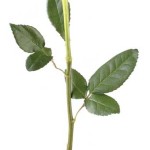The Power of Guatemalan Roses
In May, the fancy for mothers turns to roses—which have more than meets the eye or nose.
Not all plants sport flowers, but those that do use them to mate with others of their species. Appropriately, we use them to hail and express love, especially in February and May. Roses in particular are favored: red and burgundy roses in the former month as passion signatures for el Día de cariño, and white roses in the latter for el Día de la madre.
But floricultores in Guatemala and El Salvador credit violet roses with the strongest aromas. The aroma science of flowering plants is irreducibly complex, since the first purpose of the aromas is to ensure that nature’s largest symbiosis never breaks down. This is the interplay between tens of thousands of plant species and many more species of pollinating insects. Without this, life in general would cease.
Insects, then, are the flowers’ first real customers, and they are even more discerning than humans. While some insects are drawn to their flower symbiotes by visual cues, most depend on a specific chemical or combination of chemicals generated by the flowering plant. Snapdragons and petunias each produce “only” about 10 complex aromatic chemicals. This, according to Purdue University researcher Natalya Dudareva, makes these flowers practical for the study of aromas. Roses, on the other hand, generate 300 to 400 such chemicals—which explains their popularity with insects. More scents, more bugs.
It also means that while new color varieties for roses are constantly obtained, the cultivation of aromas in flowers (unlike in wines) is a hit-and-miss proposition. Either way, rose production is big business in the Guatemalan Altiplano, which provides optimum soils, temperatures and altitudes for roses. In addition to domestic demand, there is a thriving export market for about 60 varieties of roses; another flower, the bird of paradise, is also a major export. More Guatemalan flowers are exported to Holland than to any other country, with the United States being a close second.
Most Guatemalan roses are grown in greenhouses in elevated beds called tablones. A standard tablón boasts 320 rosales (rosebushes) in regimented rows. With proper pruning, each plant will yield a new flower about every three weeks. All rosebushes need relatively cool air, but there is a tradeoff related to temperature. At the higher end of the cool range, rosales are more prolific. At the lower end, they produce better flowers. The quality of a rose is gauged not only by color and aroma, but also by the integrity of the petals.
Either way, the pruning removes thinner branches, so that the rosal puts more energy and more “transcription factors” into the thicker stems. These special proteins are thought to be the element that switches on the genes that entail the generation of aromas.
Transcription factors no longer operate once a rose has been cut, but if the cutting was done right, the aroma endures, and the rose itself, when potted in water, will bring a fortnight of pleasure to its owner. For this longevity, and also for the same branch to generate more flowers, the stem must be between 40 and 70 centimeters—the length varies with variety—and the cut must be below the foliolus, a cluster of about five leaves that radiate from a point a few inches below the flower. This is why the roses we buy always wear this green garland.
Other keys to a hardy cut rose are timing and warehousing. The cut should be made at the so-called “whistle point,” when the flower, more bud than corona, is just about to open; a tiny aperture at the tip is the indicator. Also, freshly cut roses are refrigerated for 24 hours at around 54°F before going to market.
The roses are sorted and bundled, with the best flowers going to florists and the export market. Those of middling quality find their way to public mercados, and those remaining are scooped up for sale by pedestrian vendors on the Avenida Reforma and at stands near the Trebol, Guatemala City’s main traffic interchange.
The yield of a rosebush can be, and usually is, staggered by cultivators. A rosal branch needs seven or eight weeks to generate a flower, so in order to meet the high demands in February and May, specialized attention—locally called pinchado—begins in December and again in March. It is not a single procedure but a combination of grafting, vigilant pruning, hand watering, humidity modulation and intensive policing against pests and fungi. The rosales consequently produce extra flowers in the days leading up to Valentine’s and Mothers’ Day. They cannot do this year-round, so the rest of the year is their recovery period, during which they produce slightly fewer flowers.
Rosebushes are perennials, with a lifetime averaging eight years. But their gift to us may enhance our own longevity. It is one thing to give roses to your sweetheart or mother; this enhances life and—who can say?—may extend it some. But roses do even more for the sick; anyone who has endured a long, dreary hospital stay, or who has brought roses to someone else who is, knows this. Few things rally the ailing like the beauty and aroma of roses, an oasis for the eyes and the nose.


